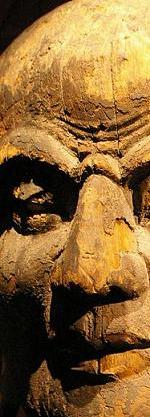Always Present Awareness (Changzhi)
Every moment of percipient consciousness includes a very basic and quite unremarkable quality of cognitive clarity. This lucid clarity in and of itself is a naturally occurring disposition (prakṛtisthagotra) of selfless, non-referential cognition, while all afflictions and defilements are adventitious, meaning that they can be removed from this basic awareness.
This awareness is likened to a clear crystal or wish-fulfilling jewel, which is utterly transparent, but when it’s placed on a red cloth the crystal appears to be red, when placed on a blue cloth the crystal appears blue, when placed on a black cloth it appears black, etc. Nevertheless, the crystal itself is not red nor blue nor black. The crystal is always completely clear. Guifeng Zongmi’s Chan Letter states:
When one truly sees the color black, the black from the outset is not black. It is just the brightness. The blue from the outset is not blue. It is just the brightness, up to and including: all the [other colors], such as red, white, yellow, etc., are like this. They are just the brightness. If, at the locus of the color characteristics, one after the other you just see the perfect brightness of jade-like sparkling purity, then you are not confused about the jewel.
Similarly, the mind has the capacity to reflect whatever presents itself to awareness, but the lucid clarity of awareness itself remains the same regardless of the contents of that awareness. Zongmi’s own auto-commentary expands upon the above passage as follows:
Everything is void. Just mind is immutable. Even during delusion there is knowing. Knowing from the outset is non-delusion. Even the arising of thoughts is knowing, [but] knowing from the outset is no mindfulness, up to and including: [at the locus wherein] pity, joy, happiness, hatred, love, and dislike [appear] one after the other they are all knowing. Knowing from the outset is voidness and calm. It is void and calm and yet knowing. Then you are not confused at all about the mind nature.
If we can calm the mind and recognize this basic quality of knowing, and then learn to sustain this basic recognition by not grasping at the various objects of awareness, then this naturally occurring knowing is where we can rest, without grasping externally nor withdrawing internally nor dwelling anywhere in-between. Zongmi goes on to add that this unstructured awareness is free from the extremes of existence and non-existence.
Jinul’s Complete and Sudden Attainment of Buddhahood adds:
It is also the perfectly bright purity of the original true nature of sentient beings which abides in pollution but is not stained, which is cultivated but becomes no purer. When defilements cover it, it is concealed; when wisdom reveals it, it appears. It is not something which comes into being due to the arising-cause; it is, rather, only understood through the understanding-cause. If someone looks back on the radiance of his own mind’s pure, enlightened nature and thereby extinguishes falsity and cleanses his mind, the myriads of images then appear together. It is just like seawater that has settled: there are no images which are not reflected. Hence it is called the ever-abiding function of the oceanseal of all phenomena in the universe. Accordingly, we can know that the perfectly bright and self-reliant functions of the dharmadhātu which remain, including the unimpeded interpenetration of all phenomena as described in the three pervasions, are never separate from the pure enlightened nature. As explained by Uisang, the dharma-nature is perfectly interfused, has no name or sign, and is free of all relativity.


Leave a comment